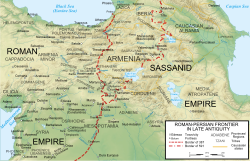The Battle of Callinicum took place on Easter Saturday, 19 April 531 AD, between an army of the Byzantine Empire under Belisarius and a Sasanian cavalry force commanded by Azarethes. After being defeated at the Battle of Dara, the Sasanians moved to invade Roman Syria in an attempt to turn the tide of the war. Belisarius' rapid response foiled the plan, and his troops pushed the Persians to the Syrian border through maneuvering before forcing a battle in which the Sasanians won a Pyrrhic victory.

The Battle of Dara was fought between the Eastern Roman Empire and the Sasanians in 530 AD. It was one of the battles of the Iberian War.
Al-Ḥārith ibn Jabalah, was a king of the Ghassanids, a pre-Islamic Arab Christian tribe who lived on the eastern frontier of the Byzantine Empire. The fifth Ghassanid ruler of that name, he reigned from c. 528 to 569, the longest of any Christian Arab ruler and played a major role in the Roman–Persian Wars and the affairs of the Syriac Orthodox Church. For his services to Byzantium, he was made patrikios and vir gloriosissimus.
The Roman–Persian Wars, also known as the Roman–Iranian Wars, were a series of conflicts between states of the Greco-Roman world and two successive Iranian empires: the Parthian and the Sasanian. Battles between the Parthian Empire and the Roman Republic began in 54 BC; wars began under the late Republic, and continued through the Roman and Sasanian empires. A plethora of vassal kingdoms and allied nomadic nations in the form of buffer states and proxies also played a role. The wars were ended by the early Muslim conquests, which led to the fall of the Sasanian Empire and huge territorial losses for the Byzantine Empire, shortly after the end of the last war between them.

The Iberian War was fought from 526 to 532 between the Byzantine Empire and the Sasanian Empire over the eastern Georgian kingdom of Iberia—a Sasanian client state that defected to the Byzantines. Conflict erupted among tensions over tribute and the spice trade.

The Anastasian War was fought from 502 to 506 between the Byzantine Empire and the Sasanian Empire. It was the first major conflict between the two powers since 440, and would be the prelude to a long series of destructive conflicts between the two empires over the next century.
Sunicas was a Hun who served in the Byzantine military during the Iberian War, in the early reign of Emperor Justinian I.
Sittas was a Byzantine military commander during the reign of Emperor Justinian I. During the Iberian War against the Sassanid Empire, Sittas was given command of forces in Armenia, similar to the status of Belisarius in Mesopotamia. He won a victory over the Sassanids at the battle of Satala.
Bouzes or Buzes was an Eastern Roman general active in the reign of Justinian I in the wars against the Sassanid Persians.
Jabalah IV ibn al-Ḥārith, known also by the tecnonymic Abū Shammar, in Greek sources found as Gabalas (Γαβαλᾶς), was a ruler of the Ghassanids. At first an enemy of the Eastern Roman Empire, he raided Palestine but was defeated, becoming a Byzantine vassal in 502 until circa 520, and again in 527 until his death a year later.
Coutzes or Cutzes was a general of the Byzantine Empire during the reign of Emperor Justinian I.
Hermogenes was an Eastern Roman official who served as magister officiorum, military commander and diplomatic envoy during the Iberian War against Sassanid Persia in the early reign of Emperor Justinian I.
Bessas was an Eastern Roman general of Gothic origin from Thrace, primarily known for his career in the wars of Justinian I. He distinguished himself against the Sassanid Persians in the Iberian War and under the command of Belisarius in the Gothic War, but after Belisarius' departure from Italy he failed to confront the resurgent Goths and was largely responsible for the loss of Rome in 546. Returning east in disgrace, despite his advanced age he was appointed as commander in the Lazic War. There he redeemed himself with the recapture of Petra, but his subsequent idleness led Justinian to dismiss him and exile him to Abasgia.
Bawi was a Sasanian military officer from the Ispahbudhan family who was involved in the Anastasian War and the Iberian War between the Sasanian and Byzantine Empire. He is also known as Aspebedes, which is a corruption of the title spahbed.
The siege of Amida occurred in 502–503, during the Anastasian War. The city was not garrisoned by any troops of the Byzantine Empire but nevertheless resisted for three months before falling to the military of the Sasanian Empire under Kavadh I. According to the detailed account of Zacharias Rhetor, the city's sack was particularly brutal, and accompanied by a massacre of the population for three days and nights. The fall of the city urged the Emperor Anastasius I Dicorus to react militarily, before a truce was agreed between both parts in 505.
Xerxes was a 6th-century Sassanid Persian prince who distinguished himself in war against the Byzantine Empire.
The siege of Petra took place in 549 when the Eastern Roman (Byzantine) Empire, under Emperor Justinian I, besieged the strategic fortress of Petra in Lazica, held by the Sasanians. Petra's garrison took heavy casualties, but it stood firm until the arrival of a strong army under Mihr-Mihroe relieved the siege.
A siege of Martyropolis occurred in Autumn of 531 during the Iberian War between the Sasanian Empire under Kavadh I and Byzantine Empire under Justinian I.
The siege of Sisauranon took place in 541 between Byzantine forces under Belisarius and the Sassanian garrison of the Sisauranon fortress under Bleschames.
Simmas was a Hunnic general in the service of the Byzantine Empire, serving as dux. Active in the early 6th century, he fought at the Battle of Dara, commanding six hundred horseman along with fellow Hun commander Ascan, and played a fundamental role in the Byzantine victory.


